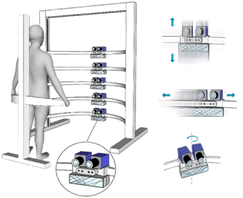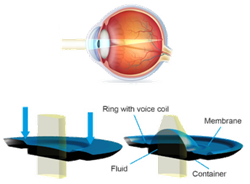The engineering tasks of the iToBoS project can be divided into two main groups. On the one hand, the design and construction of the total body scanner, that is the hardware. On the other hand, the design and implementation of the data processing and artificial intelligence software that will analyse all the information (skin images and clinical data) and generate a comprehensive output for the clinicians.
In this article, we will focus on the hardware side of the project (mostly WP3 -Specifications & WP5 – Development) and, in particular, on the special optical system needed to acquire high-resolution images of the skin of the patients.
The complexity of acquiring a full-body high-resolution avatar
The currently available systems allow doctors to take low-resolution full-body pictures of their patients and tag the positions of the skin lesions in a 3D avatar. To analyse a specific lesion, they take a local high-resolution image with a hand- held dermatoscope which can be linked to its position. The goal of the full-body scanner is to take hundreds or thousands of high-resolution pictures covering the whole body of the patient and create an avatar in which doctors can zoom in to see the details.
To acquire all the necessary images, the full-body scanner will use several cameras covering different regions of the body. This is important to keep the comfort of the patient, a key factor in the design of any medical device. In our case, comfort translates into reducing the acquisition time as much as possible. In addition, each camera will need to move following the shape of the patient’s body and acquire images perpendicular to the skin. Only by doing this, all the images will have comparable quality and it will be possible to construct a super-resolved full-body avatar.
Due to safety reasons, however, any moving element needs to be placed at a certain distance from the patient (several tens of centimetres). At such distance, the focal spot becomes very small, and features slightly closer or further from the camera are out-of-focus. Because our bodies have irregular shapes, the cameras of the full-body scanner will take several pictures focused on different distances -a stack of images- and combine them into a single image where all the regions are in focus. Acquiring a stack of images at every position multiplies the number of pictures to be taken. To keep the scan time low, the optical system needs to be able to focus very fast and precisely.

First sketches of the full-body scanner showing the various moving cameras needed to image different regions of the patient's body.
A tuneable liquid lens system for optimal image quality
Traditional optics are based on solid glass or plastic lenses which are moved back and forth to change the focus. Due to the massive nature of glass lenses, such focusing systems are bulky and slow. For this reason, the alternative given by Optotune’s liquid tuneable lenses is going to be used.
These lenses are based on the same principle as the eye: a flexible membrane closing a chamber full of liquid, which can be pressed to change the shape of the membrane and modify the focal power of the system. A change in membrane radius of a few micrometres can have the same optical effect as moving an entire glass lens several centimetres. Focus tuneable liquid lenses thus allow optical systems to be designed more compact and without complex mechanics. In addition, the optical power can be tuned precisely in only a few milliseconds and repeatably through billions of cycles.
All these properties make them the perfect match for the fast high-resolution image stack acquisition desired from the full-body scanner.

The working principle of Optotune’s focus tuneable liquid lenses is based on the eye, where elastic materials are bent to adapt the shape of the lens.
Optotune’s task in the iToBoS
The main contribution of Optotune in the iToBoS project is concentrated in Task 5.2 and consists of two big challenges: developing an optical module including a liquid tuneable lens and implementing the already proven compensation technology for gravity-induced coma.
The liquid tuneable lenses can be designed with different optical apertures and different focal power ranges to fit different applications. To be more versatile, they can also be combined with off-the-shelf imaging optics to bring the tuning capability to large and low working distances, or to telecentric lenses with constant magnification. Depending on the application, the liquid lens can be placed before or after the off-the-shelf optics. However, to optimize the image quality, the best approach is to design the liquid lens directly in the middle of the optical module. Achieving high resolution at a long distance as it is needed in the full-body scanner requires such a custom design and it is the first task for Optotune.
The second challenge is related to the biggest limitation of the liquid tuneable lenses: the coma aberration produced by gravity (or any other acceleration). In the presence of an external acceleration, the forces exerted by the liquid on different regions of the membrane are different generating a coma aberration. As a result, Optotune’s original lenses can only be used for high-resolution applications with their optical axis in a vertical orientation so that gravity affects all the regions of the lens equally. The latest of Optotune’s inventions consists in adding a second optical liquid reservoir separated from the first reservoir by a secondary membrane.
Important advances have been made and we expect to show the results soon.
